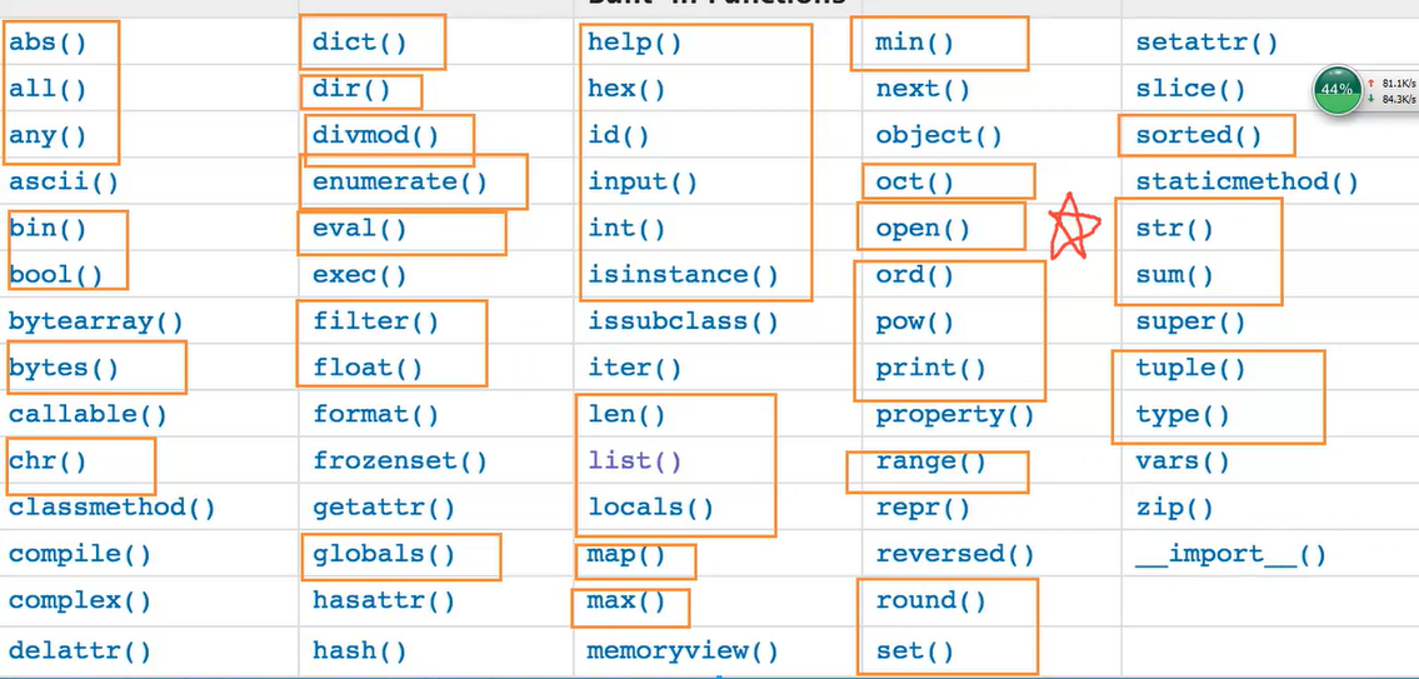1、内置函数
1.1Python的内置函数
1.2一阶段需要掌握的函数

2、随机验证码函数:

import random #assii:大写字母:65~90,小写 97~122 数字48-57 tmp = "" for i in range(6): num =random.randrange(1,4) if num == 1: rad2 = random.randrange(0,10) tmp = tmp+str(rad2) elif num == 2: rad3 = random.randrange(97, 123) tmp = tmp + chr(rad3) else: rad1 = random.randrange(65,91) c = chr(rad1) tmp = tmp + c print(tmp)
3、文件操作
使用open函数操作,该函数用于文件处理。
操作文件时,一般需要经历如下步骤:
打开文件
操作文件
关闭文件
3.1打开文件
open(文件名,模式,编码)
eg:
f = open("ha.log","a+",encoding="utf-8")
注:默认打开模式r
3.2打开模式:
基本模式:
• r:只读模式(不可写)
• w:只写模式(不可读,不存在则创建,存在则清空内容(只要打开就清空))
• x:只写模式(不可读,不存在则创建,存在则报错)
• a:追加模式(不可读,不存在就创建,存在只追加内容)
二进制模式:rbwbxbab
特点:二进制打开,对文件的操作都需以二进制的方式进行操作
对文件进行读写
-
- r+, 读写【可读,可写】
- w+,写读【可读,可写】
- x+ ,写读【可读,可写】
- a+, 写读【可读,可写】
3.3 文件操作的方法

class TextIOWrapper(_TextIOBase): """ Character and line based layer over a BufferedIOBase object, buffer. encoding gives the name of the encoding that the stream will be decoded or encoded with. It defaults to locale.getpreferredencoding(False). errors determines the strictness of encoding and decoding (see help(codecs.Codec) or the documentation for codecs.register) and defaults to "strict". newline controls how line endings are handled. It can be None, '', ' ', ' ', and ' '. It works as follows: * On input, if newline is None, universal newlines mode is enabled. Lines in the input can end in ' ', ' ', or ' ', and these are translated into ' ' before being returned to the caller. If it is '', universal newline mode is enabled, but line endings are returned to the caller untranslated. If it has any of the other legal values, input lines are only terminated by the given string, and the line ending is returned to the caller untranslated. * On output, if newline is None, any ' ' characters written are translated to the system default line separator, os.linesep. If newline is '' or ' ', no translation takes place. If newline is any of the other legal values, any ' ' characters written are translated to the given string. If line_buffering is True, a call to flush is implied when a call to write contains a newline character. """ def close(self, *args, **kwargs): # real signature unknown 关闭文件 pass def fileno(self, *args, **kwargs): # real signature unknown 文件描述符 pass def flush(self, *args, **kwargs): # real signature unknown 刷新文件内部缓冲区 pass def isatty(self, *args, **kwargs): # real signature unknown 判断文件是否是同意tty设备 pass def read(self, *args, **kwargs): # real signature unknown 读取指定字节数据 pass def readable(self, *args, **kwargs): # real signature unknown 是否可读 pass def readline(self, *args, **kwargs): # real signature unknown 仅读取一行数据 pass def seek(self, *args, **kwargs): # real signature unknown 指定文件中指针位置 pass def seekable(self, *args, **kwargs): # real signature unknown 指针是否可操作 pass def tell(self, *args, **kwargs): # real signature unknown 获取指针位置 pass def truncate(self, *args, **kwargs): # real signature unknown 截断数据,仅保留指定之前数据 pass def writable(self, *args, **kwargs): # real signature unknown 是否可写 pass def write(self, *args, **kwargs): # real signature unknown 写内容 pass def __getstate__(self, *args, **kwargs): # real signature unknown pass def __init__(self, *args, **kwargs): # real signature unknown pass @staticmethod # known case of __new__ def __new__(*args, **kwargs): # real signature unknown """ Create and return a new object. See help(type) for accurate signature. """ pass def __next__(self, *args, **kwargs): # real signature unknown """ Implement next(self). """ pass def __repr__(self, *args, **kwargs): # real signature unknown """ Return repr(self). """ pass buffer = property(lambda self: object(), lambda self, v: None, lambda self: None) # default closed = property(lambda self: object(), lambda self, v: None, lambda self: None) # default encoding = property(lambda self: object(), lambda self, v: None, lambda self: None) # default errors = property(lambda self: object(), lambda self, v: None, lambda self: None) # default line_buffering = property(lambda self: object(), lambda self, v: None, lambda self: None) # default name = property(lambda self: object(), lambda self, v: None, lambda self: None) # default newlines = property(lambda self: object(), lambda self, v: None, lambda self: None) # default _CHUNK_SIZE = property(lambda self: object(), lambda self, v: None, lambda self: None) # default _finalizing = property(lambda self: object(), lambda self, v: None, lambda self: None) # default 3.x
3.4 管理上下文
使用open方法打开后要关闭文本。
with方法后,python会自动回收资源
py2.7以后的版本with方法支持同时对两个文件进行操作
eg:with open('log1') as obj1, open('log2') as obj2:
3.5 文件日常操作
open(文件名,模式,编码)
close()
flush():将内存中的文件数据写入磁盘
read():读取指针的内容
readline():只都一行内容
seek()定位指针位置
tell()获取当前指针位置
truncate() 截断数据,仅保留指定之前的数据,依赖于指针
write() 写入数据
3.6 文件操作示例代码

#!/usr/bin/env python # -*- coding:utf-8 -*- ####基本操作方法 #默认是只读模式,默认编码方式:utf-8 # f = open('ha.log') # data = f.read() # f.close() # print(data) #只读,r # f = open("ha.log","r") # f.write("asdfs") # f.close() #只写,w ---存在就清空,打开就清空 # f = open("ha1.log","w") # f.write("Hello world!") # f.close() #只写 ,x # f = open("ha2.log","x") # f.write("Hello world1!") # f.close() #追加 a,不可读 # f = open("ha2.log","a") # f.write(" Hello world! a mode") # f.close() ### 字节的方式打开 ## 默认读取到的都是字节,不用设置编码方式 ## 1、 只读,rb # f = open("ha.log","rb") # data =f.read() # f.close() # print(type(data)) # print(data) # print(str(data,encoding="utf-8")) #2 只写,wb # f = open("ha.log","wb") # f.write(bytes("中国",encoding="utf-8")) # f.close() ### r+ ,w+,x+,a+ #r+ # f = open("ha.log",'r+',encoding="utf-8") # print(f.tell()) # data = f.read() # print(type(data),data) # f.write("德国人") # print(f.tell()) # data = f.read() # f.close() #w+ 先清空,之后写入的可读,写后指针到最后 # f = open("ha.log","w+",encoding="utf-8") # f.write("何莉莉") # f.seek(0) # 指针调到最后 # data = f.read() # f.close() # print(data) # x+ 功能类似w+,区别:若文件存在即报错 #a + 打开的同时指针到最后 f = open("ha.log","a+",encoding="utf-8") print(f.tell()) f.write("SB") print(f.tell()) data = f.read() print(data) f.seek(0) data = f.read() print(data) print(type(data)) print(type(f)) f.close()
4、lambda表达式
f1 = lambda x,y: 9+x
5、发送邮件实例代码

#!/usr/bin/env python # -*- coding:utf-8 -*- def email(): import smtplib from email.mime.text import MIMEText from email.utils import formataddr ret = True try: msg = MIMEText('邮件内容 test mail 2017-5-27 09:16:14 2017年1月27日11:16:37 2017年1月28日06:47:51', 'plain', 'utf-8') msg['From'] = formataddr(["b2b", 'john@xxx.com']) msg['To'] = formataddr(["hi hi hi ", 'john2@xxx.com']) msg['Subject'] = "主题2017年5月23日" server = smtplib.SMTP("mail.xxx.com", 25) server.login("john1", "txxx0517") server.sendmail('john1@tasly.com', ['john2@tasly.com', ], msg.as_string()) server.quit() except: ret = False return ret i1 = email() print(i1)
